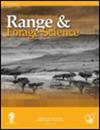在撒哈拉以南非洲以雨养为基础的巨巨猴生产:以苏丹半干旱环境为例
IF 1.9
4区 环境科学与生态学
Q3 ECOLOGY
引用次数: 0
摘要
研究了苏丹半干旱草原上雨养大巨蟒(巨蟒和巨蟒)的生长状况。连续两个季节(2020-2021年)进行了3个重复的分块完全设计试验。处理方法为两种就地雨水收集系统[即垄沟加梯田(RD)和梯田(TR)],三种播种率(即1.5、2.5和3.5公斤公顷- 1)和两种尿素施肥率[0公斤公顷- 1 (Z)和95公斤公顷- 1 (F)]。这些处理与对照(平坦,未施肥和免耕的地块)进行比较。采用水文、生物和化学指标进行评价。结果表明:采用RWH处理改善了半干旱牧场,RD处理在维持生物量产量、水分利用效率、营养品质和土壤质量方面效果最好。RD3.5处理的植株密度最高(11.2万株ha - 1)。FSR1.5-RD处理的植株长度(63.5 cm)和单株叶数(34.59)最大,而FSR3.5-RD处理的鲜生物量(25.9 t ha - 1)和干生物量(6.3 t ha - 1)均最高。施肥也显著改善了大孢霉的化学成分(即粗蛋白质、有机质和氮含量)。柽柳的水分利用效率与植物、管理和气候有关。本文章由计算机程序翻译,如有差异,请以英文原文为准。
Rainfed-based production of Megathyrsus maximus in sub-Saharan Africa: the case of the semi-arid environment of Sudan
The performance of rainfed-based Megathyrsus maximus (syn. Urochloa maxima and Panicum maximum) was investigated in the semi-arid pastures of Sudan. Split-plot complete design experiments with three replications were applied for two consecutive seasons (2020–2021). The treatments were two in situ rainwater harvesting systems [i.e. ridges plus terraces (RD) and terraces (TR)], three seeding rates (i.e. 1.5, 2.5 and 3.5 kg ha−1) and two urea fertilisation rates [0 kg ha−1 (Z) and 95 kg ha−1 (F)]. These treatments were compared to a control (a flat, unfertilised and zero-tillage plot). Hydrological, biological and chemical indicators were used in the assessment. The results showed that the adopted RWH improved semi-arid pastures, with the RD treatment providing the best results for sustaining biomass production, water use efficiency, nutritional quality and soil quality. The highest plant density (112 000 plants ha−1) was associated with the RD3.5 treatment. The FSR1.5-RD treatment resulted in the greatest plant length (63.5 cm) and number of leaves per plant (34.59), whilst the FSR3.5-RD resulted in both the highest fresh biomass (25.9 t ha−1) and dry biomass (6.3 t ha−1). The chemical compositions of M. maximus (i.e. crude protein, organic matter and nitrogen contents) were also substantially improved by fertilisation. The water use efficiency of M. maximus was plant-, management- and climate-dependent.
求助全文
通过发布文献求助,成功后即可免费获取论文全文。
去求助
来源期刊

African Journal of Range & Forage Science
ECOLOGY-ENVIRONMENTAL SCIENCES
CiteScore
4.00
自引率
14.30%
发文量
35
审稿时长
>12 weeks
期刊介绍:
The African Journal of Range & Forage Science is the leading rangeland and pastoral journal in Africa. The Journal is dedicated to publishing quality original material that advances rangeland ecology and pasture management. The journal aims to publish research of international importance from any region, but as an African journal, we are particularly interested in research from Africa and relevant to the continent. The Journal promotes both science and its application and authors are encouraged to explicitly identify the practical implications of their work. Peer-reviewed research papers and research notes deal primarily with all aspects of rangeland and pasture ecology and management, including the ecophysiology and biogeochemistry of rangelands and pastures, terrestrial plant–herbivore interactions (both domestic and wild), rangeland assessment and monitoring, effects of climate change on rangelands, rangeland and pasture management, rangeland rehabilitation, ecosystem services in support of production, conservation and biodiversity goals, and the identification and development of intensive and semi-intensive pasture and forage resources to meet livestock production needs. Articles highlighting transdisciplinary linkages among biophysical and social sciences that support management, policy and societal values are particularly encouraged. The Journal includes relevant book reviews and invited perspectives that contribute to the development of range and forage science. Letters to the editor that debate issues raised in the Journal are acceptable. The African Journal of Range & Forage Science is the official journal of the Grassland Society of Southern Africa.
 求助内容:
求助内容: 应助结果提醒方式:
应助结果提醒方式:


